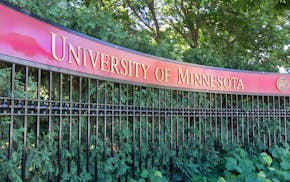A longtime northeast Minneapolis bar and restaurant is concerned that a planned MnDOT construction project will claim its building, and owners are taking matters into their own hands to rally public support.
Last week, Stanley's Northeast Bar Room turned to social media to let people know the 15-year-old restaurant at University and Lowry avenues could be slated for the wrecking ball and replaced with a roundabout.
"We felt nobody knew what would happen," said Luke Derheim, one of the co-owners of Craft & Crew Hospitality, which operates Stanley's. "We felt like we had to get the word out [on] how this would impact the community."
MnDOT will reconstruct University between 27th and Central avenues NE. starting in 2027. The agency recently released four designs for remaking the crash-prone and congested intersection of Lowry and University.
The plans include building a roundabout or shifting Lowry Avenue slightly to the north or south of the current alignment. In all four potential designs, MnDOT will acquire some property. The agency is accepting feedback through Friday on the plans, and for two designs proposed for University and NE. Broadway.
Though MnDOT conducted community engagement last spring and summer – more than 2,000 people weighed in – the latest round is critical as the agency plans to make final decisions by May and ask the city of Minneapolis for municipal consent this summer.
That was news to Derheim, who said it became clear in January that Stanley's was in danger.
Crashes are a common occurrence at University and Lowry. From 2020 to 2024, MnDOT data shows there were 126 collisions at the corner, or a rate of 3.4 wrecks per million vehicles entering the intersection. That is four times higher than the statewide average for similar intersections, MnDOT said.
Stanley's itself has not been spared. The bar, Derheim said, has been struck 25 times over the years. Fire hydrants, business signs, fencing and signal equipment have been wiped out, too.
"We know firsthand it is an issue," he said. "We are trying to come up with a solution that would not require ripping down a 130-year-old building that has been a restaurant and institution in the community for so long."
Just last year, Stanley's added a large year-round patio, where patrons bring their dogs, with hopes of using it for years to come.
But under three of the proposed designs, Stanley's would have to give up a portion of its property, and that would likely spell the end of the line for the neighborhood institution.
"If they take a corner of our building, I don't know how we'd operate on that spot anymore," Derheim said. Rebuilding on the remaining parking lot or moving to a new location is out. "We don't see a viable option to do that."
MnDOT's plan to redo University includes transforming the thoroughfare from four lanes to three with a center turn lane. The agency also plans to make other improvements to reduce speeding, improve safety by adding medians and removing parking, and widening sidewalks to comply with the Americans with Disabilities Act.
At Lowry and University, three other businesses also could be affected, depending on which intersection design is chosen. Those include a smoke shop, an auto body shop and the Olive and Lamb restaurant.
The University Avenue redo also includes plans to alleviate safety concerns at the intersection of NE. Broadway, which has the second-most crashes after Lowry on the corridor.
"That is a gnarly intersection," MnDOT spokesman Ricardo Lopez said.
One plan calls for building a roundabout. A second calls for creating separate right turn lanes in the southwest corner of the intersection to reduce conflicts between vehicles and pedestrians. Boulevard space would also be added between the roadway and the sidewalk. Some property would be lost.
"Unfortunately that happens with road projects," said Lopez, who added that University is a truck route with problems that need to be fixed. "We try to minimize the property impacts."
Derheim said it's wait and see what MnDOT comes up with and hopes the agency will keep businesses in Minneapolis and the fabric of the neighborhood intact.
"The community needs to have a voice," Derheim said.

Drunk, unlicensed driver who fatally hit University of Minnesota student gets prison term

14-year-old boy fatally shot in downtown Minneapolis
As measles spreads nationwide, fewer Minnesota kindergartners have 'herd immunity'

Minnesota State Mankato makes big cuts to academic offerings to save money, meet student and employer demands

